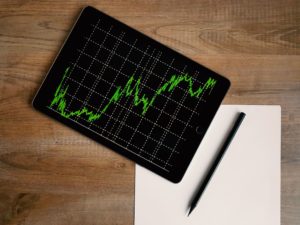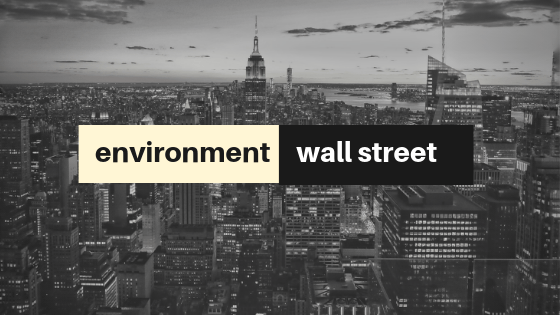We can all agree that we are more divided than we’ve been in generations in the US. Our political system is extremely partisan, ideologies have become increasingly polarizing, and income, race, gender, and educational inequality are rising. This has made it increasingly difficult to find common ground to even talk to “the other side.” Sustainability provides an incredible opportunity for common ground, whether it’s Environmentalists vs. Wall Street, climate deniers vs. activists, or Republicans vs. Democrats, we will use this series to unpack how to talk to the other side and use sustainability strategy to bring people together to solve our myriad of social, environmental, political, and financial problems.
A sustainable business shouldn’t be an oxymoron. Here’s how to bridge the gap and find common ground between the environmentalist and the Wall Street suit.

- Go green to get green: Sustainable businesses perform better
One of the biggest misconceptions is that sustainable and green business initiatives will be costly and affect a business’ bottom line. However, this couldn’t be further from the truth. An excellent example of this can be found in the markets. The S&P 500 Environmental and Socially Responsible Total Return Index, an iteration of the S&P 500 with a collection of environmental and socially responsible corporations, consistently outperforms the S&P 500, through good times and bad. Companies that are part of the Carbon Disclosure Project show an 18% higher return on equity over peers, and more sustainable companies see 50% less volatility in earnings than low-ranking peers. It turns out that green can make you some green as well.
Many misunderstandings between these two groups arise because of the different language that environmentalists and profit-driven Wall Street types use. When environmentalists talk about the environment, their arguments don’t resonate with business leaders because they have different priorities and goals. Environmentalists might focus on emotional, gut-wrenching rhetoric: “the polar bears are drowning,” and “sea levels will rise and destroy ecosystems.” This may seem irrelevant to someone who is trying to streamline its business model and focus on the bottom line.

In order to find common ground, learn to speak in their language. Perhaps the most important motivator for an environmental dissenter is profit, and sustainable business is a great way to improve the triple bottom line.
- Get with the program: Investors care and companies need to embrace ESG
Another key motivator for a profit-driven individual is innovation and being ahead of the curve. Sustainability is no longer news: it is being adopted at increasingly faster rates in corporate arenas. Additionally, individuals are understanding the worth of corporate responsibility too. In 2003, the Carbon Disclosure Project had 35 investors, surveyed 245 companies, and assessed $4.5 trillion worth of assets. Today, the CDP has over 525 socially responsible investors, surveys over 5300 sustainable businesses, and assesses over $100 trillion worth of assets.
ESG reporting as a whole is growing as well, and sustainability training is becoming an assumed part of corporate strategy. To date, there are 383 reporting instruments available for corporations interested in participating in a corporate responsibility or sustainability assessment. 71 countries participate in these reports, and $20 trillion in assets are invested in ESG activities.
CEO’s agree that sustainable business solutions are key for the long-term growth of their businesses. In the recent UN Global Compact Accenture CEO Study on Sustainability, 93% of CEOs agreed that sustainability was important to the future of their business, 80% agreed that sustainability is an area for gaining a competitive advantage, and 84% believed their business should lead efforts to define and deliver sustainability goals.
Rather than making a “save the planet” argument, environmentalists should persuade Wall Street types with this convincing information.

- Bad for the planet is bad for business: Negative environmental effects also cause negative financial effects
Many economic models treat factors such as pollution and climate change as factors unrelated to the performance of an economy. However, it is impossible to extricate the two from one another, because the economy depends on our environment. In fact, a recent report from the Federal Reserve found that the US is creating an international market failure because these factors have not been incorporated into projections and long-term investments.
Destroying the environment comes with severe financial costs. We have already seen the economic devastation that can befall local communities as a result of extreme weather, hurricanes, forest fires, floods, and blizzards. For example, one of the most talked-about financial effects of climate change is the shorter snow season. By some reports, the snow season has decreased by almost a full month, creating serious revenue issues for businesses that rely on this income. This is serious business: the winter sports industry is valued at over $20 billion, and climate change is already taking a cut.
The vicious cycle of climate change also creates a vicious financial cycle. As the planet heats, there is less snowfall, creating a shorter ski season and faster runoff. As a result, forests dry earlier, there are more fires, and the cycle starts all over again. This cycle has an economic multiplier effect on the hospitality and retail industries tied to winter sports. In addition, it increases the cost of water for farmers and leads to higher taxes to pay for recovery from these environmental disasters.
- Save resources and save money: Financial savings from conservation
One of the biggest anxieties about embracing sustainable policies is the price tag. Although, the truth is that one of the best things for a business or investor is to reduce unnecessary expenses. Whether it is energy, water, paper, or plastic, wasteful habits are simply cost ineffective. All businesses should consider simple environmental strategies to enhance shareholder value before taking actions like lay-offs or salary cuts. For example, almost 95% of all the water that enters our homes goes down the drain from toilets and sinks. Only 1% of the products we buy are still in use six months after their sale. Paying attention to consumption saves money on the front end, and on the back end in terms of disposal.
Energy is also one of the largest contributors to this costly waste. Whether it’s through unused rooms that are lit, an open door with the air conditioner running, or an appliance plugged in when out of town, a huge amount of energy is wasted every day. In fact, almost as much energy is wasted as is produced annually. In the United States, a staggering 58% of all energy produced is wasted.

DuPont recently adopted optimized energy and distribution at its facilities, adding new technologies that had lower energy consumption. After a sustainability assessment, they reduced their CO2 emissions 72% below the Kyoto target. Additionally, they also. managed to also save $3 billion and expand their businesses by 30%. Amazon is another success story, using waste heat recovery to heat 4 million square feet of the Amazon campus. This sustainable business strategy saves 4 million kilowatts annually, and also saves over $210,000 annually in energy bills. Rather than focusing on the environmental benefits, pitching these green business initiatives as cost-saving programs can be profitable and sustainable.
It can be difficult to navigate a conversation with someone that seems to have very different values and priorities. Although, the reality is that there is much more common ground than you might expect. When working to convince a profit-driven person to take environmental measures, speak their language. Emphasize that sustainable businesses are proven to perform better, more and more companies are adopting ESG principles as the cutting-edge of long-term development, negative environmental effects also create financial issues, and that conservation can actually create significant cost savings. With patience, you’ll be a sustainability expert armed with tools to communicate and problem solve with the “other side.”
EDITOR’S NOTE: The opinions expressed here by Impakter.com columnists are their own, not those of Impakter.com.














